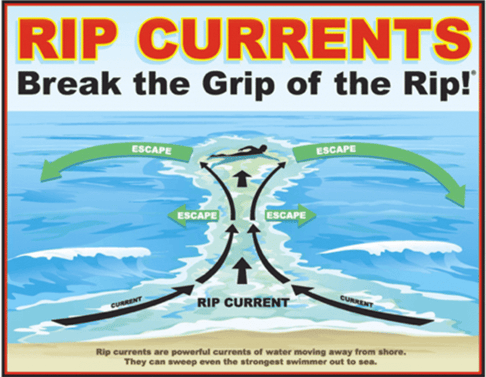How to Spot a Rip Current?
Learn how to spot a rip current and how to escape its deadly grip. Staying safe in the water. Essential tips and actions to take. Don't miss this important guide!.
OPINION


Imagine you're enjoying a beautiful day at the beach, basking in the sun and playing in the refreshing ocean waves. Suddenly, you find yourself caught in a powerful current that pulls you away from the shore. This is a rip current, a common and potentially dangerous phenomenon that can pose a significant threat to swimmers. Understanding how to react when caught in a rip current is crucial for your safety. In this blog post, we will explore what rip currents are, why they occur, and most importantly, what steps you should take if you find yourself stuck in one. By knowing the right actions to take, you can effectively navigate these challenging situations and ensure your well-being in the water.
Understanding Rip Currents: Before diving into what to do when stuck in a rip current, it's important to grasp what rip currents actually are. Rip currents are strong, narrow channels of water that flow away from the shore and into the open ocean. They are typically formed by a combination of factors such as wave and tide patterns, underwater topography, and weather conditions. Rip currents can occur on any beach with breaking waves and can be particularly common near piers, jetties, and in areas with sandbars.
Recognizing the Signs: Being able to identify the signs of a rip current is crucial for your safety. Look out for the following indicators:
a) Noticeable differences in water color and texture, such as a darker hue or choppier appearance. b) Foam, seaweed, or debris moving steadily out to sea. c) Waves breaking on both sides of a calmer, smoother strip of water.
If you observe these signs, it's likely that you've encountered a rip current. It's important not to panic and remain calm.
What Not to Do: When you realize you're caught in a rip current, it's essential to avoid certain actions that could exacerbate the situation or put you at greater risk. Here's what NOT to do:
a) Don't panic or exhaust yourself by swimming against the current, as rip currents are stronger than even the most experienced swimmers. b) Avoid trying to swim directly back to shore, as this will only tire you out and make it harder to escape the current. c) Do not rely on flotation devices, such as air mattresses or inflatable toys, as they may not provide sufficient support against the force of the current. d) Refrain from attracting undue attention by shouting or waving your arms vigorously, as this may distract potential rescuers from your actual position.
Actions to Take: When caught in a rip current, it's essential to remain calm and take the following actions:
a) Swim parallel to the shore: Instead of fighting against the current, swim parallel to the beach until you feel the current weakening. Rip currents are typically narrow, so swimming perpendicular to the flow can help you escape its pull.
b) Float or tread water: If you find it difficult to swim parallel to the shore, conserve your energy by floating or treading water while you call for help. This will allow you to stay afloat and maintain visibility while waiting for assistance.
c) Utilize wave direction: When attempting to escape a rip current, wait for an incoming wave and use its momentum to propel yourself towards the shore. The force of the wave can provide a temporary boost, helping you move closer to safety.
d) Signal for help: If you're unable to escape the rip current on your own, attract the attention of lifeguards or nearby beachgoers by raising your arm, shouting, or using a whistle if available. Drawing attention to your situation increases the chances of getting assistance.
Prevention and Precautions: While knowing how to respond when stuck in a rip current is crucial, it's equally important to take preventative measures to reduce the risk of finding yourself in such a situation. Here are some precautions to consider:
a) Swim near lifeguard stations: Lifeguards are trained to identify and respond to rip currents promptly. Staying close to their stations provides an added layer of safety.
b) Observe warning signs and flags: Pay attention to any beach signs or flags indicating hazardous conditions. If warnings are in place, it's advisable to avoid swimming altogether or to restrict your activity to designated safe areas.
c) Educate yourself: Learn about rip currents, their causes, and how to identify them. Being knowledgeable about this natural occurrence can significantly enhance your ability to recognize and react to rip currents effectively.
d) Swim with a buddy: Having a swimming companion can provide mutual support and increase the chances of getting help in case of an emergency.
Conclusion: Finding yourself caught in a rip current can be a distressing experience, but knowing what to do and remaining calm are crucial for your safety. By understanding how to identify rip currents, avoiding panic, and taking the appropriate actions, you can increase your chances of escaping their grip unharmed. Remember, prevention is key, so take the necessary precautions, stay informed, and always swim in designated areas with lifeguard supervision. With the right knowledge and mindset, you can enjoy the ocean's beauty while keeping yourself safe from the potential hazards of rip currents.



